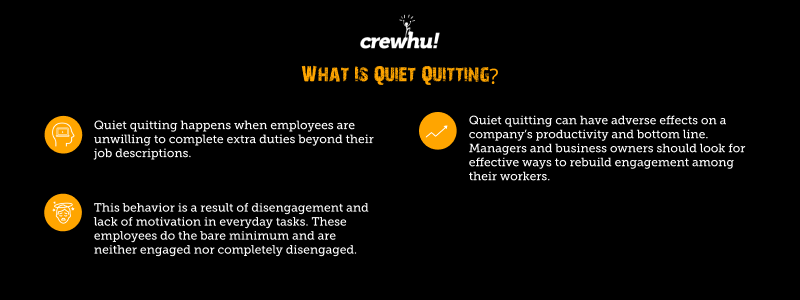What Is Quiet Quitting?

Why companies are worried about this new trend

Ever had an employee who came in on time, performed their duties, then clocked out and went home? No putting in extra time, no attending non-mandatory meetings and events, no volunteering for tasks beyond their assignment scope.
The phrase “quiet quitting” has become popular recently thanks to social media, but the behavior it describes has been around for a while. There are many reasons for this phenomenon, but the current trend is connected to employee disengagement. According to Gallup, the percentage of engaged employees dropped from 36% pre-pandemic to 32% in 2022, and the highest drop was seen in employees who work exclusively remotely.
This silent resistance to doing more than the bare minimum can harm your company’s productivity. So what is quiet quitting, why should it matter to your organization, and what can you do to reduce it? Here’s what you need to know.
What is quiet quitting?
When someone says, “quiet quitting,” they’re not talking about workers actually walking off the job. Rather, this behavior involves employees completing their assignments and responsibilities without going above and beyond their job descriptions.
Quiet quitters fulfill their primary obligations by doing the bare minimum. They are unwilling to engage in activities outside their scope, such as staying late or answering emails over the weekend. Research by Gallup shows that at least half of the U.S. workforce is unwilling to go the extra mile. But following the Great Resignation, with more than 40% of employees considering a job change, quiet quitting is becoming detrimental to organizations’ efforts to meet their goals.
Why are employees quiet quitting?
The primary cause of this disturbing trend is employee disengagement. When workers disengage from the company’s values and purpose, they become uninterested in committing or volunteering for any responsibilities beyond their primary ones.
Quiet quitting can also be caused by other reasons, including:
- Stressors such as the Covid-19 pandemic and challenging economic times
- Employees feeling unappreciated and unrecognized even after giving their best
- Burnout from heavy workloads and juggling hybrid work with other commitments
- Lack of inclusion and diversity in the workplace
- Employees realigning their priorities or work-life balance
While scaling back the amount of work they take on has the potential to improve employee wellness, foster a better work-life balance, and establish healthy boundaries in line with their needs, it’s often a sign that there’s something wrong in the workplace. It could indicate burnout and disengagement, which affect productivity. It could also signify that an employee is unhappy with their position and not experiencing job satisfaction.
A Harvard Business Review workplace study showed that quiet quitting has less to do with an employee’s willingness to go the extra mile than it does with the manager’s and business owner’s ability to build good relationships with employees. So if your employees are tuning out, you should be concerned.
Why companies should care about quiet quitting
Should organizations worry about this new trend?
Absolutely.
While employees who engage in quiet quitting may have more time to rest, improve their social lives, and strike a healthy work-life balance, the overall phenomenon is a symptom of an unsatisfying work environment. This will cause other problems such as reduced productivity and lack of motivation.
In the HBR study, business managers who balanced attaining results with concern for their employees’ needs saw 62% of their workers willing to put in additional effort, while those who weren’t concerned about their employees’ wellness saw only 20% of their employees willing to go beyond their responsibilities.
At first, employees doing the bare minimum may not seem like a problem. After all, they’re still performing their core tasks. However, this trend should concern employers for several reasons:
- Most responsibilities can’t be exhaustively defined in a job description. They require the employee to step up and take on additional work. Other times, the manager may not oversee everyone and their specific tasks, so the company relies on employees to pick up the slack.
- In this age of remote and hybrid working, most jobs require employee collaboration and extra effort to meet goals and company demands.
- A workforce willing to put in the extra effort is a competitive advantage to an organization.
- Employees experiencing burnout are less engaged, less motivated, and less productive, and more prone to making mistakes.
Business owners should strive to create a healthy work environment that benefits both the company and its employees. The best way to do this is by keeping workers engaged and avoiding burnout. Engaging remote workers and making them feel appreciated can be as simple as offering regular words of encouragement. But you also have to go the extra mile to foster employee wellness.
Engage your workers before they begin to quiet quit
It’s best to start engaging your employees before they start quiet quitting, but even if they’ve already begun, you can rebuild engagement and get back on track with your goals. To do this, you’ll need to implement engagement programs. Talk to your workers, listen to what they say, and discuss how to make them feel more appreciated. Some solutions to consider:
Gamify your tasks
Applying game elements to everyday tasks helps motivate and engage employees. Come up with contests, team-based competitions, and game-like goals. These could be simple interactive leaderboards, point-based reward systems, or even goal-tracking progress bars. Tap into your employees’ competitive natures.
Recognize and reward achievements and contributions
Employees love to feel appreciated. Offer rewards such as bonuses, badges, or gift cards when they hit their goals. Recognize excellent work by implementing a rewards and recognition program or offering other public recognition. This will foster friendly competition and boost motivation.
Prioritize employee wellness and personal development
Avoid burnout by prioritizing employee wellness. Encourage your employees to sign up for wellness programs; you can even offer to pay for their gym memberships. Alternatively, develop your own programs and get your employees involved. It can be anything from prioritizing mindful breaks to creating fitness challenges, weight loss competitions, or community service initiatives.
Let CrewHu help keep your employees engaged
Employee engagement is important for any organization that wants to prevent quiet quitting and its negative effects on productivity. Implementing engagement programs can be challenging, especially when you don’t know where to start. That’s why you need a reliable partner to help you rebuild employee engagement.
CrewHu helps businesses keep their employees engaged and motivated by fostering a culture of collaboration and recognition. We’ll help you gamify your tasks and implement a rewards and recognition program. Don’t struggle with quiet quitting like everyone else. Book a CrewHu demo today, and let us show you how to keep your employees motivated.






